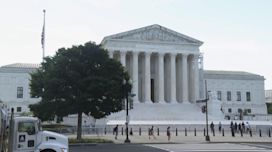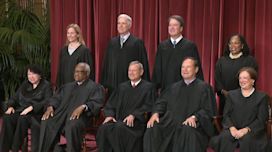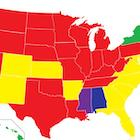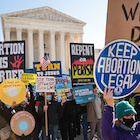Search results
Roe v. Wade, 410 U.S. 113 (1973), was a landmark decision of the U.S. Supreme Court in which the Court ruled that the Constitution of the United States generally protected a right to have an abortion.
People also ask
What did the Supreme Court decide in Roe v Wade?
What was Roe v Wade vs Planned Parenthood v Casey?
Was abortion illegal before Roe v Wade?
What is Roe v Wade & Dobbs v Casey?
4 days ago · Roe v. Wade, legal case in which the U.S. Supreme Court on January 22, 1973, ruled (7–2) that unduly restrictive state regulation of abortion is unconstitutional. The Court held that a set of Texas statutes criminalizing abortion in most instances violated a constitutional right to privacy.
- The Editors of Encyclopaedia Britannica
Videos - Roe v. Wade
2 years after Roe reversal, abortion becomes major campaign issue
CBS News Videos2 weeks agoMonday marks two years since the Supreme Court overturned Roe v. Wade. President Biden is campaigning on restoring abortion rights while former President Trump is touting his role in the reversal of the landmark case. Nancy Cordes has more.
Up Next
- 3:022 years after Roe reversal, abortion becomes major campaign issueCBS News VideosMonday marks two years since the Supreme Court overturned Roe v. Wade. President Biden is campaigning on restoring abortion rights while former President Trump is touting his role in the reversal of the landmark case. Nancy Cordes has more.2 weeks ago
- 1:21Where do legal challenges to abortion bans stand 2 years after Roe v. Wade was overturned?ABC News VideosThe U.S. Supreme Court has yet to issue a decision in a key case this year.2 weeks ago
- 2:31How a North Carolina abortion clinic has become a sanctuary for out-of-state patientsCBS News VideosTwo years ago, the U.S. Supreme Court overturned Roe v. Wade, ending the constitutional right to an abortion. CBS News got exclusive access to one clinic in North Carolina that has seen a stream of more out-of-state patients seeking care.2 weeks ago
- 4:51DNC chair talks reproductive rights on Dobbs decision anniversaryABC News VideosDNC Chair Jamie Harrison discusses voter concerns on the 2-year anniversary of Roe v. Wade being overturned.2 weeks ago
- 1:49Biden campaign marking Dobbs anniversaryABC News VideosOn the second anniversary of the Supreme Court decision overturning Roe v. Wade, The president is hoping to rally support for his campaign, promising to restore access to abortions if he's reelected.2 weeks ago
- 2:20Trump touts Dobbs decision in speech to evangelicalsCBS News VideosBefore a room of conservative Christians at a gathering of the Faith & Freedom Coalition in Washington, D.C., Saturday, former President Donald Trump Saturday touted the Supreme Court's decision two years ago to overturn Roe v. Wade as he seeks to shore up his support among evangelicals. Natalie Brand reports.2 weeks ago
- 1:28The state of abortion rights in the US two years after the Supreme Court overturned Roe v. WadeAssociated Press VideosJudges, state lawmakers and voters are deciding the future of abortion in the U.S. two years after the Supreme Court jolted the legal status quo with a ruling that overturned Roe v. Wade3 weeks ago
- 2:29Supreme Court preserves access to mifepristone in major abortion-related rulingCBS News VideosOn Thursday, the Supreme Court rejected restrictions on a widely used drug, mifepristone, used in abortion pills. It was the court's first major abortion-related ruling since it overturned Roe v. Wade two years ago. More decisions from the court are expected Friday.3 weeks ago
- 1:43Mifepristone may still be available, but opponents say the fight is not overAssociated Press VideosThe Supreme Court unanimously preserved access to a medication that was used in nearly two-thirds of all abortions in the U.S. last year, in the court’s first abortion decision since conservative justices overturned Roe v. Wade two years ago.4 weeks ago
- 4:08Trump touts role in overturning Roe v. Wade, Biden to meet with families of slain officersCBS News VideosFormer President Donald Trump was in Wisconsin and Michigan Wednesday where he hyped up his part in overturning Roe v. Wade and defended his policy of letting states make their own abortion laws. On the Democratic side, President Biden is heading to Charlotte, North Carolina, to meet with the families of the law enforcement officers killed in a shootout this week. CBS News senior White House and political correspondent Ed O'Keefe has more on the campaigns.2 months ago
Jun 24, 2022 · The U.S. Supreme Court has overturned the constitutional right to an abortion, reversing Roe v. Wade, the court's five-decade-old decision that guaranteed a woman's right to obtain an abortion.
- Nina Totenberg
Roe v. Wade is the Supreme Court case that held that the Constitution protected the right to an abortion prior to the viability of the fetus. In 2022, the Supreme Court reversed Roe and Planned Parenthood of Southeastern Pennsylvania v. Casey (see entries on Dobbs v.
Mar 27, 2018 · Roe v. Wade was a landmark legal decision issued on January 22, 1973, in which the U.S. Supreme Court struck down a Texas statute banning abortion, effectively legalizing the procedure...
Jan 22, 2012 · Roe v. Wade: A person may choose to have an abortion until a fetus becomes viable, based on the right to privacy contained in the Due Process Clause of the Fourteenth Amendment. Viability means the ability to live outside the womb, which usually happens between 24 and 28 weeks after conception.
In 1970, Jane Roe (a fictional name used in court documents to protect the plaintiff’s identity) filed a lawsuit against Henry Wade, the district attorney of Dallas County, Texas, where she resided, challenging a Texas law making abortion illegal except by a doctor’s orders to save a woman’s life.























